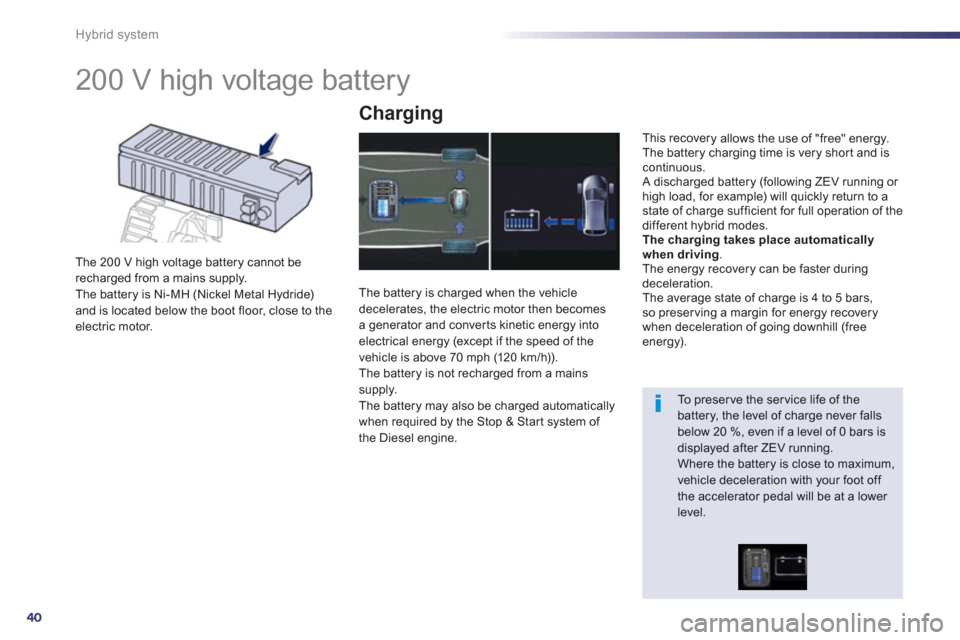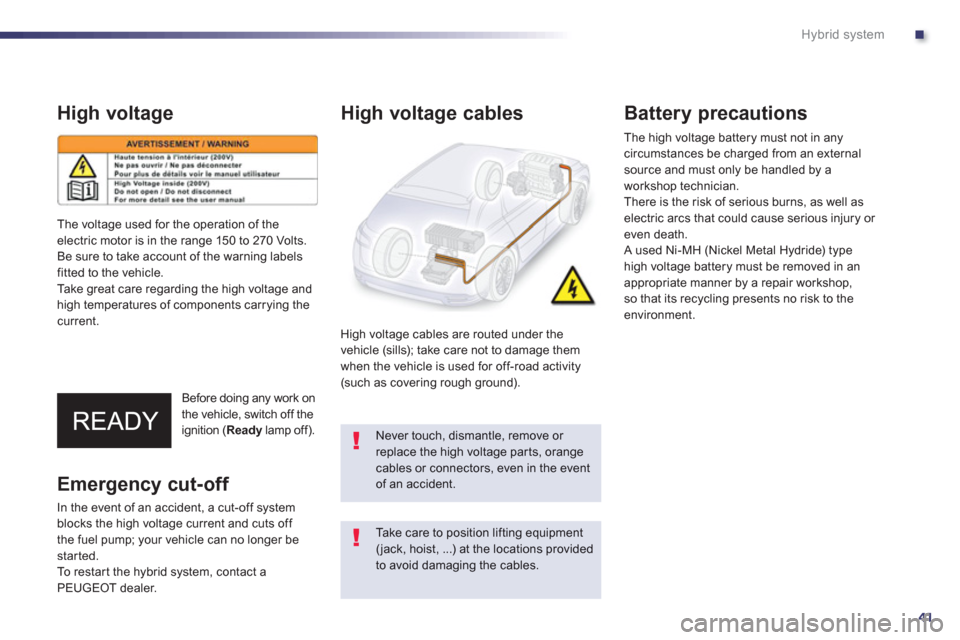Page 34 of 304
32
Hybrid system
Energy consumption / generation indicator
The indicator dial provides real time information
on the total power used, combining electric and
Di
esel.
It comprises three main zones.
CHARGE zone
Zone which indicates that the vehicle isin electrical energy recovery
phase:
on deceleration, braking or foot off the
accelerator, ...
This allows the high voltage battery to be recharged using "free" energy
which can thenbe reusedfor future energy requirements.
POWER zone
Zone which indicates an increased cumulative power demand
from your hybrid vehicle,
taking account of the combined capacities of
the Diesel engine and the electric motor.
Z
one which indicates that the vehicle is
optimising its energy consumption, electric,
Diesel or a combination of both.
This zone corresponds to phases of electric
running as well as to phases of optimum use of
the Diesel engine, which are easily accessible
with a suitable driving style (smooth "eco-citizen" driving).
ECO zone
Page 35 of 304
.
33
Hybrid system
View hybrid fl ow information
Hybrid modes
1.
Hybrid mode selected (AUTO, ZEV, SPORT, 4WD). 2.Messages, e.g.: "Zero Emission" if the Diesel engine is off (0 g/km CO2).
Vehicle infrastructure
3.Diesel engine.4.
Tr a c t i o n b a t t e ry state of charge.
5. Electric Motor/Generator.
Operation / Energy flows
6.
The Diesel engine supplies the battery (if needed).
7.Arrow from left to right: the battery powers the electric motor (when the electric motor is operating).
Arrow from right to left: the electric motor/generator recharges
the battery (energy recovery phases). 8. The Diesel engine drives the front wheels. 9.The electric motor drives the rear wheels. Information on the active h
ybrid mode, arrows for energy flows and the state of charge of the battery, is displayed in the instrument panel screen or
the screen.
Page 36 of 304
34
Hybrid system
Examples of displays
On starting and when stationary
There is no flow of energy (the Stop & Star t system stops and restar ts the Diesel engine automatically).
Energy recovery
During this phase (deceleration, braking, foot off the accelerator, … all modes), the battery is recharged by the electric motor/generator,
then being driven by the rear wheels.
You can maximise this ener
gy recovery by taking your foot off
the accelerator pedal, deceleration will then be less marked than
with
a conventional vehicle.
100% electric
In all electric running (AUTO or ZEV modes), only the electricmotor, powered by the battery, drives the rear wheels.
The display of "Zero Emission" indicates that the Diesel engine
is off and the vehicle is producing no CO2.
Page 37 of 304

.
35
Hybrid system
Automatic restarting of the Diesel engine or ZEV mode NOT available
The internal combustion engine may restar t or ZEV mode may not be available in the various conditions presented below.
The internal combustion engine can be switched off automatically as soon as these conditions are lifted. When the conditions described below causethe vehicle to come out of ZEV mode and the Diesel engine to restar t, the vehicleautomatically changes to AUTO mode.
Diffi cult weather conditions and circumstances
- If certain conditions or engine
temperature requirements make it necessary (such as an enginetemperature that is too low for the ambient conditions). - When the battery is close to maximum charge (for example: when goingdown a long hill), because enginerecovery being no longer possible, theinternal combustion engine restarts automatically just to provide engine braking.- If the vehicle encounters a steep slope (car park ramp, ...).- If the vehicle has been parked in the sun for a prolonged period.- When driving in mountainous conditions (altitude).
Your vehicle is fitted with the most effectiveemissions control systems, in par ticular theParticle Emissions Filter (PEF). At regular intervals your Diesel engine will produce energy for the self-cleaning of this filter.During this PEF regeneration phase, electric running is purposely made unavailable.
Maintaining the performance of the system
- When the vehicle exceeds 18 mph
(30 km/h) after moving off (if the internal combustion engine has not alreadystarted since the vehicle was last started). - If the high voltage battery is notsufficiently charged. A minimum of 4 bars in ZEV mode so as to ensure operation over a cer tain distance (in AUTO, electric operation isaccessible for a shor ter period witha lower level of charge). - When the fuel level enters the reserve zone (where rate of consumption of this reserve is high, ZEV inhibition maycontinue for some time after refuelling).- During regeneration of the par ticle emissions filter, which occurs
automatically for 5 to 10 minutes, approximately every 300 miles(500 kms) (or less in extended urban running).
Action by the driver
- Moving the gear selector to position M.
- Action on steering mounted controlpaddles to change gear.
- Sustained and sharp acceleration.
- Use of demisting.
- Use of air conditioning.
Page 42 of 304

40
Hybrid system
200 V high voltage battery
The 200 V high voltage battery cannot berecharged from a mains supply.
The battery is Ni-MH (Nickel Metal Hydride) and is located below the boot floor, close to the electric motor.
Charging
The battery is charged when the vehicledecelerates, the electric motor then becomes
a generator and converts kinetic energy intoelectrical energy (except if the speed of the
vehicle is above 70 mph (120 km/h)).
The battery is not recharged from a mains
supply.
The battery may also be charged automatically
when required by the Stop & Star t system of
the Diesel engine.
This recover
y allows the use of "free" energy.
The battery charging time is very shor t and iscontinuous.
A discharged battery (following ZEV running or high load, for example) will quickly return to astate of charge sufficient for full operation of the
different hybrid modes.Thecharging takes place automatically
when driving.
The energy recovery can be faster during deceleration.
The average state of charge is 4 to 5 bars, so preser ving a margin for energy recovery
when deceleration of going downhill (freeenergy).
To preser ve the ser vice life of the battery, the level of charge never falls below 20 %, even if a level of 0 bars is displayed after ZEV running. Where the battery is close to maximum, vehicle deceleration with your foot off the accelerator pedal will be at a lower level.
Page 43 of 304

.
41
Hybrid system
High voltage
Before doing any work on
the vehicle, switch off the
ignition ( Ready lamp off).
y
High voltage cables
High voltage cables are routed under the
vehicle (sills); take care not to damage them when the vehicle is used for off-road activity (such as covering rough ground).
Battery precautions
The high voltage battery must not in anycircumstances be charged from an external
source and must only be handled by a
workshop technician.
There is the risk of serious burns
, as well as electric arcs that could cause serious injury or even death.
A used Ni-MH (Nickel Metal Hydride) type high voltage battery must be removed in an
appropriate manner by a repair workshop,so that its recycling presents no risk to the environment.
Take care to position lifting equipment(jack, hoist, ...) at the locations provided to avoid damaging the cables.
The volta
ge used for the operation of theelectric motor is in the range 150 to 270 Volts.
Be sure to take account of the warning labels
fitted to the vehicle.
Take great care regarding the high voltage and high temperatures of components carrying thecurrent.
Emergency cut-off
In the event of an accident, a cut-off system
blocks the high voltage current and cuts off
the fuel pump; your vehicle can no longer bestarted.
To restar t the hybrid system, contact a
PE
UGEOT dealer.
Never touch, dismantle, remove or replace the high voltage par ts, orange cables or connectors, even in the event of an accident.
Page 44 of 304
42
Hybrid system
Fan cooling of the high voltage battery
The high voltage battery has an air coolingsystem, comprising an air intake (located on
the rear shelf) and a fan (located behind the
boot trim).
This s
ystem does not work continuously,
but adapts the force of the fan cooling to the requirements of the battery.
Its operation can be heard at the rear, even if
the vehicle is stopped after a run.
If the air intake is blocked, the battery may
overheat, damaging the battery and causing a
loss of performance of the hybrid system.
For the best use of the high voltage battery, please follow these recommendations: - do not obstruct the air intakewith loose articles, otherwise, the battery may overheat, causinga loss of performance of the hybrid system ,- do not spill fluids, as this may causedamage to the battery.
Page 54 of 304

52
Instruments and controls
Serviceon temporarily. A minor fault has occurred for which
there is no specific warning lamp. Identify the fault by reading the message shown on
the screen, such as, for example:
- the h
ybrid system,
- the closin
g of the doors, boot or bonnet,
- the engine oil level,
- the screenwash level,
- the remote control battery,
- saturation of the par ticle emission filter (Diesel).
For any other faults, contact a PEUGEOT dealer or a
qualified workshop.
fixed. A major fault has occurred for which
there is no specific warning lamp. Identify the fault by reading the message shown on the screen and contact a PEUGEOT dealer or aqualified workshop.
PEF: particle emissions filter,Diesel
fixed, associated
temporarily with a message on the risk of
FEP filter blockage.Thi
s indicates the start of saturation
of the par ticle emissions filter. As soon as traffic conditions permit, regenerate
the filter by by driving at a speed of of least 36 mph(60 km/h) until the ser vice warning lamp goes off.
fix
ed.This indicates the low level of theDiesel additive reservoir. Have it topped up as soon as possible by a PEUGEOT
dealer or a qualified workshop.
Warning / indicator lampStateCauseAction / Observations